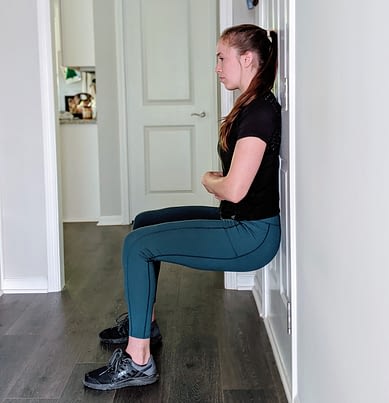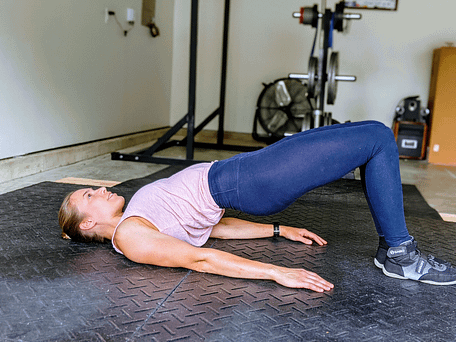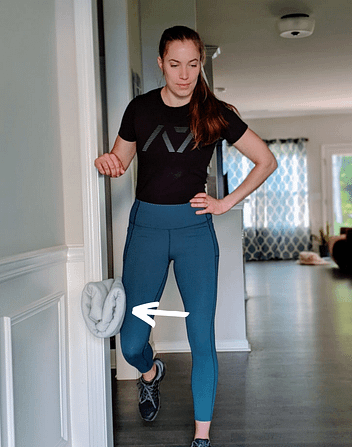Pain at night is simply the worst. It makes it difficult (if not impossible) to have restful sleep. And in the morning, you wake up feeling drained and weary.
If knee pain disrupts your sleep, this article is for you.
Here are 13 ways to relieve knee pain and help you get a good night’s sleep.
1) Pillow Under The Knees
When lying on your back, place a pillow under your knees (or use two for extra support). This is the best way to put the knees in a comfortable sleep position.
Imagine pulling your pinky finger back and holding it there for an hour. It will get sore, right?

This is an end range position. Joints get sore in prolonged end range positions.
Sleeping on your back with the knees straight puts the knees near full extension (straightening). Over several hours, this position can cause knee joint pain and stiffness.

Instead, when you sleep on your back, put a pillow under your knees. This is the best sleeping position for your knees. Plus, it can alleviate lower back pain!
Related: 5 Reasons You Have Low Back Pain in the Morning
2) Pillow Under The Shins
If you’re a stomach sleeper (like I am), position one or two pillows under your shins. Once again, strategic pillow placement keeps the knees in a mid-range position and prevents them from being fully extended all night.
Plus, your ankles will be happier with a pillow under your shins. Try it out!
3) Pillow Between The Knees
Most people are side sleepers. Sleeping with a pillow between the knees can be a game changer for knee pain. However, many people position the pillow wrong. This mistake can actually exacerbate knee issues–can you see it in this picture?

It’s crucial to support the entire leg with pillows, not just the knees. If the lower leg isn’t supported, the knees will be forced into a bow-legged (varus) position.

This is an aggravating position for sore knees. The knees work like door hinges. They bend and straighten, and that’s about it.
Irritable knees don’t like frontal plane (side to side) forces. The knees aren’t built to move that way. (In fact, strong ligaments prevent too much side to side movement at the knees)
When you support your knees in sidelying, make sure to support your entire lower leg in a neutral position. Use two pillows, for the upper leg and one for the lower leg. Or opt for a top-rated body pillow to support for the entire leg.
4) Ice, Ice Baby
Grab an ice pack for powerful pain relief. Ice reduces knee swelling, increases knee ROM and boosts quad strength (1) for people with knee arthritis. Combine cold therapy with the next two tips for serious pain relief before bed.

It’s wise to use ice in 15-20 minute intervals. Longer durations can numb the skin and lead to frostbite. That’s the last thing your knees need!
“20 minutes on, 20 minutes off” is standard protocol for using cold packs.
5) Compression
Compression is the x-factor for swollen, achy joints. It helps in 3 ways:
First, compression provides joint warmth, easing pain with daily activities. Second, compression enhances knee stability and proprioception (coordination), making movement feel better. Finally, compression reduces swelling.
Swelling keeps knees tight and achy. So reducing swelling alleviates stiffness and pain.
For knee compression, I advise many patients to pick up a continuous knee sleeve (not one of the knee braces with a hole in the front for the kneecap). I direct them to this top-rated knee sleeve.
6) Elevation
Elevation is the final component of the pain relief trio. Remember the acronym I.C.E–ice, compression, elevation. These 3 ease achy knees, especially before bedtime.
Elevation is more than kicking your foot up on a stool while you’re sitting at work, or putting your feet on the Ottoman while you watch TV.
It’s key to elevate the knee above the heart. This encourages swelling to move out of your leg, towards your torso. Subsequently, swelling leaves the knee and knee pain eases.
It’s a good idea to perform ice, compression and elevation together. Not only does compression reduce swelling, it eases pain and boosts confidence in people with knee arthritis (2).
7) Good Sleep Hygiene
Sleep hygiene refers to activities and habits around sleeping. Bad sleep hygiene causes poor sleep.

There are a host of ways to improve sleep hygiene. Examples include sleeping in a cool room, keeping the bedroom as dark as possible, and avoiding alcohol right before bed.
If you’re interested in learning more, check out Sleep Smarter, an easy read that’s chock full of strategies to get deep, restful sleep.
Better sleep hygiene can help you fall asleep faster and rest more peacefully. And high quality sleep translates to faster healing and less pain.
8) Treat it Right
Knees can hurt from lack of movement. Or they can hurt because of too much physical activity.
Nighttime knee pain can stem from too much (or too little) activity during the day. After a busy day, pain signals seem clearer when we’re laying in bed without distractions.
Common causes of knee pain include sitting with the knees bent for long periods of time, high impact activities like running or jumping, and walking up and down hills or stairs.
Often, reducing aggravating activities during the day dulls knee pain at night. Instead, opt for gentle movements, like these low-impact exercises.
Movement is a key piece of every great daily routine. It’s good for the mind and the body. It’s good for the knees too.
Movement lubricates the knee cartilage and provides nutrition to the knee joints. As a general rule, it’s okay to exercise through mild pain, as long as the symptoms aren’t worse the next day.
9) Get Stronger
Strengthening the quadriceps and glutes will reduce knee pain and improve your quality of life.
Try these 3 exercises for stronger knee and hip muscles.
Wall Sits
Sit against a sturdy wall. (Or door that won’t open unexpectedly!) Start with the hips high, and work into a lower position as you get stronger. Keep the hands off the thighs!

I hated wall sits during soccer practice. The muscle burning and shaking is intense! Wall sits are great for quad strength. Start with the hips high. The lower you sit (like Liz in the picture), the harder it is.
Time yourself on your watch. Over time, aim to hold longer and sit deeper.
Glute Bridges
Bridges are a simple exercise that strengthens the glutes, hamstrings and lower back muscles.

Perform with arms on the floor, pushing through both legs to lift your hips off the floor. To make it harder, increase hold time and repetitions.
Hip Burners
This isometric exercise strengthens the gluteus medius muscles (on the outside of the hip) and activates the quadriceps in a functional position.

Gently push sideways into the towel. Hold 5 seconds. Relax. Repeat. See if 10 repetitions of 5-second holds doesn’t torch your glutes!
These 3 exercises improve blood flow to the soft tissues around the knee. Plus, exercise has a naturally pain-relieving effect known as exercise-induced analgesia.
10) Maintain a Healthy Body Weight
It’s much easier said than done. I’m all for body positivity and everyone feeling confident in their body, regardless of size or stature.
But excess body weight is bad for the knees. It’s a fact–the research is crystal clear.
Extra pounds add extra pressure to the knee joints. Obesity causes more inflammation in the body and quadruples the risk of knee arthritis (2).

Fortunately, weight loss and exercise are effective treatments for reducing knee pain for individuals with obesity (3).
Healthy body weight is largely influenced by sleep, nutrition, and exercise. We discussed sleep hygiene in section #7.
To get your nutrition on track, I recommend the Understanding Healthy Eating e-book to learn the practical science behind good nutrition.
To discover the best low impact exercises for knee pain, check out this article:
The 7 Best Cardio Exercises for Bad Knees
11) Stretch It Out
Now I’m not a fan of stretching for the sake of stretching. It’s often a waste of time.
However, stretching out the knees before bed may ease pain and induce better sleep. In particular, many achy knees move better after seated knee extensions.

First, assess your baseline pain with a mildly uncomfortable exercise or activity. For example, let’s say walking causes 3/10 pain. Next, do 10 or 15 knee extensions, holding each one 10 seconds. Then, walk again and see if symptoms improve.
If so, consider doing this exercise throughout the day for fast pain relief.
12) Heat It Up
If ice isn’t making a dent in your knee pain, try a heating pad instead. Alternatively, take a warm bath before bed. A warm bath will help you fall asleep faster and have higher quality sleep! (4)
“Heat or Ice?”
Patients often ask whether they should use heat or ice. Whichever option feels best is usually the most effective (5). Even alternating heat and ice can help!
13) See a Physical Therapist
Physical therapy is an excellent option for chronic knee conditions. PTs are trained to determine the source of your knee pain and treat it right. When an issue isn’t suitable for physical therapy, PTs know when to refer to an appropriate healthcare provider.
Knee pain is rarely a serious medical issue. However, there are a few “red flags” that indicate medical attention may be warranted:
- Pain is only at night
- Pain is unrelenting
- Changing positions doesn’t help
- Significant unexplained weight loss
- Fever
- History of knee trauma
When in doubt, seek evaluation from a qualified professional. A skilled healthcare provider will give you good advice about the best treatment plan for your specific situation.
Wrapping Up
There are many effective strategies to reduce knee pain and sleep better. If you’re dealing with severe pain or chronic knee problems, it’s wise to work with a professional to get the appropriate treatment and put you on the path to recovery.
Readers: Do you have knee pain that keeps you awake at night? What helps you sleep better? What doesn’t work? Share your experience in the comments.
For more evidence-based insights you won’t find anywhere else, join the free, fast-growing Facts & Physio Newsletter. Plus, get The Recovery Checklist when you sign up.

